I'm interested in how people actually use this to learn, and to what degree the lessons fit with people's learning habits and are conducive to learning. Your feedback will help me design a better interface and lesson.
- How did you study? (for example, where, how often, for how long)
- About how long did it take to learn one unit (row of 5 symbols) of writing?
- Was there anything confusing about the explanations? Anything particularly interesting or enjoyable?
- Any other questions, comments suggestions?
Lesson 1, Step 1
Step 1 is a quick introduction to some basics and will have you reading Japanese and translating your first sentences.NB - if you're using a smart phone, please turn the screen to landscape orientation. As of Dec 20, for best results view on Chrome or Opera; audio will be provided to replace the approximate pronunciation guide.
Nouns
The Japanese noun does not distinguish for number, or gender.There are no articles (a/an/the).
がくせい (gakusei) can mean ‘a student’, ‘the student’, ‘students’, and ‘the students’.
Verbs
The Japanese verb does not distinguish for number; it uses the same form whether the subject is singular or plural. There is also no distinction of form for first, second and third person. Thus:|
I am You/we/they are He/She/It is |
are all expressed by the word です (desu). |
Sentences and Word Order
The verb comes at the end of the sentence.がくせい です。
a student - s/he is, I am
students - they/we are
This simple sentence can mean 'I am a student.’ 'They are students.’ etc. In conversation, as in writing, the context will make the meaning clear.
Writing
A brief introduction to Japanese writing
※※※Japanese uses phonetic symbols, called kana, and Chinese characters, called kanji.
There are two forms of kana; hiragana, which has a smooth, cursive appearance and is used for words of Japanese origin and katakana, which has an angular look and is used to write foreign words. The kana are a 'syllabary' - one syllable, one symbol. For example, the sound 'deh' is represented in hiragana as で and in katakana as デ. The symbols have no meaning in and of themselves, but can be combined with other symbols to form a word.
Kanji each represent an idea and may be pronounced in more than one way. Although these symbols can be complex, they follow a system, which them which makes memorization easier.
A note on romanization. "Romanizaton" is the rendering of non-western languages into roman letters. With the exception of pronunciation guises, these lessons use the Hepburn system.
※※※
To learn the symbols, practice by writing. This is something you learn with your body as much as your mind.
Stroke order is important. It helps you form the symbols correctly, and helps with remembering the more complex symbols. You can download a worksheet HERE which shows the correct stroke order. (Source: happylilac.net)
Start by learning the first row of the hiragana. Approximate pronunciation is given below.
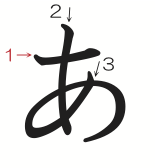
| 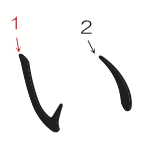
| 
| 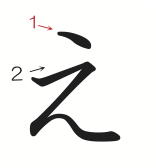
| 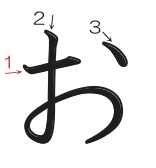
|
| ah | ee | oo | eh | oh |
Here are some tips for efficient learning
It is much better to do five 5-minute sessions than one thirty minute session.
Copy one symbol a few times until you can write it without looking. Then do the same with the next symbol. Once you've gone through all five, try to write the whole row without looking. Note which symbols, or kana, you find hard to remember. (You can capture this information easily if you use paper and pencil. When you can't remember the symbol, leave a space and go to the next one. The spaces in your row will tell you what needs more work.) Practice those symbols a few times and then try to write out the row again.
If you don't have pen and paper handy, use the tool below to get started!
NB if you don't see the handwriting recognition field, check to see if your browser is blocking the page.
When you can write all five of these hiragana, test yourself by reading the words below. If you have to look back at the chart above in order to decode what you see, write out the row again until you can complete it without looking.
Below are some words that are be written using the hiragana you have learned so far.
| あい | いえ | うえ | あう | いう | おう | あおい |
| love | house | above | to meet | to say | to chase | blue-green |
Congratulations! You're reading Japanese.
Here are the next 5 symbols, and some more words to read.
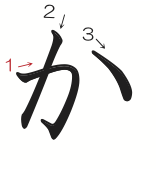
| 
| 
| 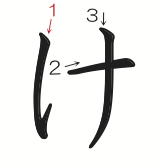
| 
|
| ka | ki | ku | ke | ko |
| あかい | えき | こえ | こく | おけ |
| red | station | voice | country | bucket |
Learn the next row of the hiragana, the 'sa-retsu' (or 'sa' row), and try the mini-quiz below. (You will now know about one-third this script.)

| 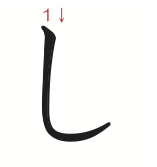
| 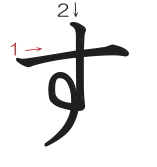
| 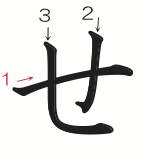
| 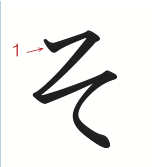
|
| sa | shi | su | se | so |
You may know these words: さけ すし
What do these sentences mean?
(Hint: see "Sentences and Word Order" above.)
あかい です。
すし です。
Bonus – how would you write:
“It’s a house.”
You're reading Japanese and writing sentences. If you learn five symbols a day, it will now take you less than a week now to learn the complete hiragana. Lesson one distributes that work over the remaining three steps. The audio recordings and hints in the exercises will allow you to begin learning the language patterns before you know all the symbols.
次へ